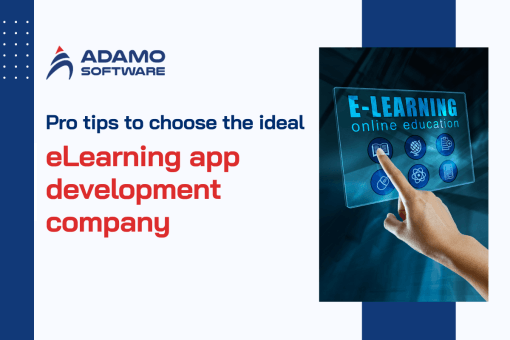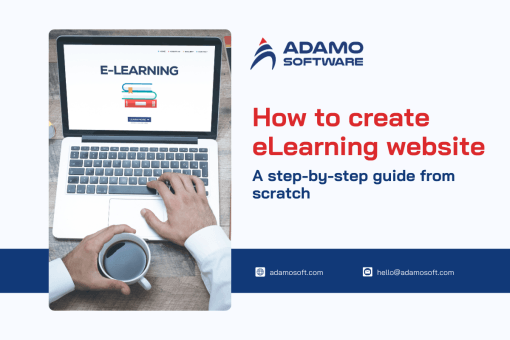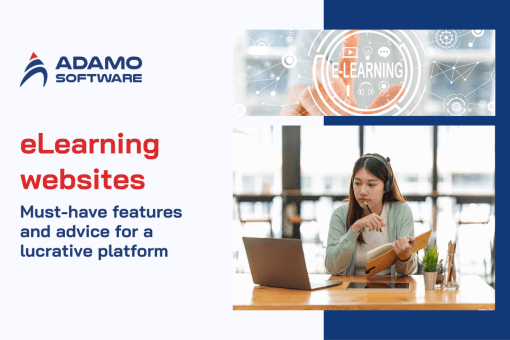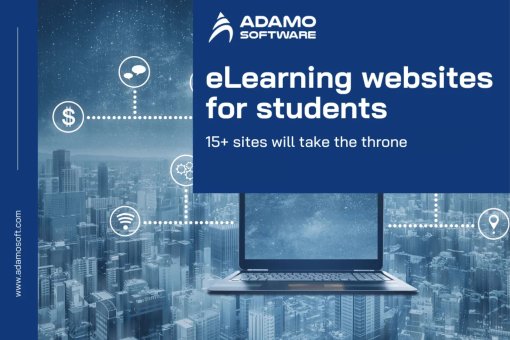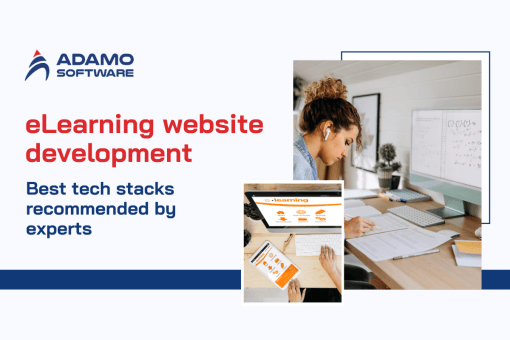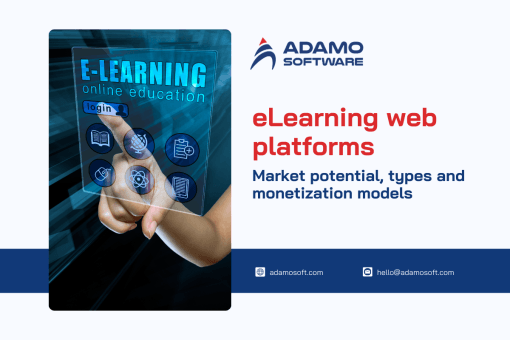E-Learning Platform Development: Features, Tech Stack, Cost, and How to build

Digitalization is an indispensable part of the life that we are living today. The tremendous impacts that it brings have transformed many aspects of our world, including how we are learning. These days, online learning platforms are no longer something unfamiliar to us. It is now possible to acquire knowledge on almost any subject provided we have a strong connection to the Internet.
Yet, the demand for these kinds of platforms is still rising. Statista anticipates that the annual growth rate for this sector will be 5.26% for the 2024-2029 period. This creates many possibilities for business in the edtech industry. Suppose you are searching for some novelties to update your educational services. In that case, you can opt for e-learning platform development.
Need help figuring out where to begin? This article will offer you all the information you need to know about the e-learning platform. It will serve as the ultimate guide for you on this journey. Let’s find out what other advice we have for you that is worth its weight in gold!
I. Introduction about e-learning platform development
E-learning platform development entails designing learning and training platforms to be delivered online. Such platforms can include online classrooms, tests, and collaborative spaces. The main goal of e-learning platform development is to provide learners with an exciting and effective process of learning. Some typical features of e-learning platforms include:
- Content management system (CMS): Facilitates the easy input, storage, and retrieval of educational material.
- Intuitive interface: The appearance of the learning content must be easy to navigate and have features that accommodate different learners.
- Interactive learning tools: Videos, quizzes, and discussion forums help increase students’ interest and their ability to retain what they have learned.
- Personalization: Adaptive learning paths and personalized recommendations help finish courses based on the learner’s performance.
- Assessment and feedback: Aids for assessments and timely feedback to measure the learning achievements made by the students.
Overall, e-learning platform development focuses on creating a comprehensive digital space that meets varied educational needs effectively.
II. Purpose of e-learning platform development
E-learning platform development is the process of designing, implementing and enhancing the learning-teaching process by using Information and communication technologies. These platforms perform several essential tasks which enrich the learning process. The primary purposes of an e-learning platform include:

- Delivering online courses: With e-learning, students can attend their classes online from anywhere and at any time.
- Creating and sharing instructional materials: Teachers can share content in different types of media, such as videos, PowerPoint presentations, and text documents.
- Interacting and collaborating online: Tools like discussion forums, chats, and wikis can facilitate students’ online participation and sharing of knowledge.
- Evaluating and providing feedback: Teachers can assess students’ performance and even offer their feedback through the Internet, hence enhancing students’ performances.
- Personalized learning: With e-learning applications, students can learn according to their own pace and preferences, which increases their motivation.
III. Key features of an e-learning software

1. Intuitive interface design
Design an interface that is user-friendly for both teachers and students. This is crucial for providing clear icons and text for easy navigation. Most instructors are still transitioning to digital resources such as eBooks and online learning platforms. Therefore, it is important to ensure that they are easy to use when conducting e-learning platform development.
2. Developing video-based content
The integration of video-based content is an innovative concept in the e-learning platform development process. This feature enables students to view the lessons at their own convenience so that they can access all important instructional content. The availability of lessons at all times is a great advantage, especially when it is a highly desired feature.
3. Offering live tutorials
Investing in live tutorials and sessions is crucial. These features offer prompt answers to students’ issues. This is possible thanks to instructors responding to questions on the spot. The platform can also have online classroom support, where students and teachers can discuss certain issues in a virtual setting. This helps close the communication loop and enhances the learning process in e-learning platform development.
4. Supporting multiple languages
For an e-learning platform, you should care about the international audience, meaning including multiple languages on your platform. This feature helps students and learners from all over the world easily navigate through the platform. Including popular languages will increase the platform’s popularity and greatly enhance its effectiveness due to the inclusion of diverse users.
5. Enabling offline access
Though the system will be mainly used for online learning, offline functionality must also be incorporated. The platform should allow students to download content easily if they want to use it later. The distribution of offline educational materials is essential in situations where Internet use is restricted. Thus, giving users the choice to download content guarantees that they can study effectively even if they are offline.
6. Incorporating interactive features
E-learning platforms may include activities such as small tests, audiovisual content, simulations, and gamification. Moreover, they should also allow students to take notes, perform info searches, and collaborate with others if necessary. These features enhance not only the learning process but also the students’ interaction with the course content.
7. Offering personalization options
Users are more likely to engage with an app that allows them to personalize it. This is also the case with e-learning apps. To ensure users can benefit the most, these platforms should be appropriate for users of different ages. Therefore, personalization features must be diverse, from mock tests and report cards to custom learning plans, etc. The app should also provide practical solutions to problems that each learner is likely to face.
8. Implementing analytics tools
An analytics tool is essential for evaluating the impact of the learning program and the teaching methodologies. It provides an overview of students’ learning behaviors, facilitating teacher decision-making. This tool enables an educator to see such things as students’ reviewed content and the percentage completion of the course. With this data, teachers can change their approaches to teaching and improve the content of their lessons. Moreover, they can provide additional assistance to the learners in a timely manner on an online platform.
IV. Essential tech stack for building a successful e-learning app
When it comes to building an effective e-learning platform, technology choice is critical to its success. Below are the essential factors to consider in e-learning platform development:

1. Front-end technologies
The front-end is the part of an e-learning platform that the end-user interacts with. It is responsible for delivering an enjoyable experience. Key front-end technologies for e-learning platform development include:
- React.js: A JavaScript framework that is used in the creation of modern and interactive user interfaces.
- Angular: A strong front-end framework that is perfect for creating single-page applications (SPA).
- Vue.js: A progressive JavaScript framework that is very fast and easy to understand and use.
2. Back-end technologies
The back-end of an e-learning platform deals with the server-side processes, data and proper integration with different services. Prominent back-end technologies in e-learning platform development include:
- Node.js: A server-side JavaScript runtime environment that has been designed for developing high-performance applications.
- Python (with Django or Flask): A general-purpose scripting language with solid backing from web development frameworks such as Django and Flask.
- Ruby on Rails: A web application development framework on the model’s client-side known for its speed and versatility.
- Java (with Spring): Java is a strong programming language combined with Spring for developing enterprise-class applications.
3. Database management
The management of data plays an essential role in e-learning platform development. Here are some widely used database options:
- MySQL: One of the most used open-source RDBMS in the world.
- PostgreSQL: A free, modern, feature-rich, and highly reliable open-source relational database management system.
- MongoDB: A database that is designed to store unstructured data is NoSQL.
4. Learning management system (LMS)
LMS is essential in the administration, monitoring, and dissemination of learning material in e-learning platforms. Outstanding open-source LMS options include:
- Moodle: A very flexible and packed LMS that is used widely in learning institutions.
- Totara Learn: A fully customizable and highly expandable LMS which provides for extensive reporting and compliance tools.
- Chamilo: A simple-to-use LMS that is targeted at collaborative learning and social interaction.
5. Video streaming and conferencing
Video streaming and conferencing should be integrated into e-learning platform development to make learning more engaging. Some of the potential solutions include:
- WebRTC: An open-source project allowing for Real-Time Communication (RTC) in web browsers.
- Wowza Streaming Engine: A high-performance media server for live and on-demand streaming.
- Jitsi Meet: A free and shared video conferencing tool with screen-sharing and recording functions.
6. Content management system (CMS)
CMS is essential for the administration of educational material within an e-learning environment. Key CMS options include:
- WordPress: A very open-source and versatile CMS with many plugins and themes to choose from.
- Drupal: A reliable and sound CMS that is characterized by its enterprise level.
- Contentful: A CMS that enables content to be created and managed independently of publication to different platforms and channels.
7. DevOps and cloud services
DevOps and cloud services make it possible to achieve better scalability, reliability, and cost optimization in e-learning platform development. Prominent tools and services include:
- Docker: A platform that allows for an application to be deployed in a similar manner across multiple environments.
- Kubernetes: An open-source system that provides automation for deploying, scaling, and managing applications that are based on container technology.
- AWS: A diversified cloud computing service that provides a number of services, such as computing, storage, and data services.
- Microsoft Azure: A strong and comprehensive computing platform that offers solutions to develop, host, and run applications.
Also read: 20 Best Free e-learning platforms (2024 Top List)
V. The ultimate guide for a strong e-learning platform development
An e-learning platform development is not a simple procedure and must be well planned and executed. This list covers all the main steps that will help make your e-learning environment relevant and stimulating.

1. Step 1: Identify and understand your target audience
First of all, you need to define what audience your platform is going to be designed for. Design your platform according to the needs of your users. Some may want to take a quiz, while others may want to learn through case studies, or simulations.
2. Step 2: Develop a strategic content plan
Next, you need to come up with a content strategy that will suit them. First, define the curriculum and the main topics. Then, choose the best formats of presentations, which may be videos, podcasts, or even simulations. Remember: quality content should always come first. Even the best e-learning platform development will not work if the content is wrong or boring.
3. Step 3: Budgeting and resource allocation
There are certain principles that can be followed while designing an e-learning platform, and one of them is financial planning. Set a budget that is consistent with the vision but sufficient for the quality, design and further maintenance and updates. It is also important to use resources efficiently. For example, focus more on areas such as content creation that are important for the functioning of the platform.
4. Step 4: Assemble a skilled development team
Once the above steps are completed, work with professional developers for the next steps of e-learning platform development. In many cases, it is better to outsource the project to developers who can offer different approaches and ideas. It is therefore important that you get the right development partner to work with as you develop your platform.
5. Step 5: Select core technologies
It is crucial to select the proper technologies for your platform to be stable and develop properly. To create an e-learning platform, use the basic web technologies such as HTML, CSS, and JavaScript. To improve the speed and stability of development, it is possible to use frameworks, for example, Angular or React. For enhanced visual elements and united design, use libraries like Bootstrap.
6. Step 6: Design with UX in mind
It is not all about beauty, but also about usability – smooth and enjoyable. Design the platform to follow the principles of UX/UI so that users can easily navigate through the site. Make use of the responsive design to ensure that the content can be accessed on all devices. In addition, multimedia such as videos and simulations can be used to enhance the content.
7. Step 7: Follow an agile development process
Once you have your design ready, start the development phase using Agile processes so that you can incorporate feedback frequently. Testing is very important. Make sure your platform is responsive to different devices and is easy to navigate. After launching, you must perform regular updates of the content, bug fixes, and feature improvements as per users ‘ feedback.
VI. Cost to create your own e-learning platform
The cost estimate of custom e-learning platform development is as different as planning a vacation at a basic level or a luxury level. The costs are usually from $50,000 to $200,000, depending on the factors that define the final cost.
Some factors that Influence the cost are:
- Project complexity: The complexity of the e-learning platform is a major cost driver. A basic platform with limited features will be more affordable than a comprehensive, multilingual platform with advanced functionalities.
- Website type: The type of e-learning website directly affects the cost. For instance, a single-instructor platform designed for local use is far less expensive than a large-scale MOOC platform.
- Developers’ rate: The rates charged by developers vary widely based on their location, expertise, and experience. Balancing your expenses and quality is very important. While hiring a less experienced freelancer might reduce costs, it may result in a platform that doesn’t fully meet expectations. On the other hand, partnering with a reputable e-learning platform development company ensures high-quality results, though at a higher cost.
In conclusion, the cost of developing a custom e-learning platform reflects the platform’s complexity, scope, and quality. Understanding the value behind each expense is essential for making informed decisions. Investing in a well-designed e-learning platform can yield significant returns in the fast-growing online education market.
VII. Adamo provides excellent services for e-learning software development
An online learning platform is a great choice for making use of the latest technologies and revolutionizing your educational offerings. If you are considering doing e-learning platform development and don’t have much experience with this, let Adamo Software help you!

Adamo Software is a leading Vietnamese company in the field of software development. We have worked with many clients around the world on multiple successful projects in software development across various sectors. Educational software is also one of our areas of expertise. Our IT experts with experience from previous projects can help you with your e-learning platform development in no time! We can guarantee that you will get a high-quality solution for a reasonable cost and accelerate your educational operations.
Contact us to get started on the e-learning platform development that will take the learning experience to the next level!






